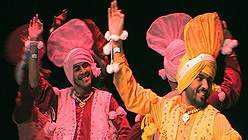In any given year, spring would be an appropriate season for an art institution to explore Passover themes. But the Contemporary Jewish Museum exhibit New Works/Old Story: 80 Artists at the Passover Table comes during an especially fitting year. As the San Francisco museum’s invitational exhibition showcases artists’ interpretations of the seder plate used during Passover, a holiday with history and retelling at its core, the museum itself is both looking to its future and reflecting on its past.
In June 2008, after nearly a decade of planning and construction, the Contemporary Jewish Museum settled into its new home, a Daniel Libeskind-designed adaptation of the landmark Jessie Street Power Substation. Noted for its striking blue steel façade, the redesigned historic building, on Jessie Square in San Francisco’s SoMa neighborhood, provides more than 10,000 square feet for the museum’s exhibition space, education center, store and café.
The institution celebrates its 25th anniversary in 2009. With its quarter-century history and long-awaited new home both squarely in the spotlight, the museum devotes its 2009 Dorothy Saxe Invitational to the central object in one of Judaism’s most widely celebrated holidays. Key to the ceremony, but without religious guidelines regulating its form, the seder plate, which is used to hold the traditional foods served on the first night of the eight-night holiday commemorating the Israelites’ exodus from Egypt, lends itself to a particularly wide variety of artistic interpretations.
Not surprisingly, the seder plates created for the exhibition range from traditional versions to conceptual objects, from the irreverent to straightforward displays of craftsmanship. A hand-carved limestone and brass serving plate by Amy Klein Reichert looks like it could be part of a real seder meal; a plate constructed of pencils and office supplies by Grace Hawthorne and Phoebe Streblow of Readymade magazine plays with the idea of everyday objects in a ceremonial space. Artist Gay Outlaw’s stackable paper plates reference the simplicity and haste associated with the first Passover meal, and Harriete Estel Berman’s ornate metal plate abounds with symbolic imagery from Jewish history.
Spark gets a closer look at this show. Taken together, the many objects on display during this juried exhibition combine to educate onlookers about Judaism’s past while raising questions about its present and future — not unlike the holiday itself.
Resources
- Array
- Array
- Array
- Array
Related Episodes
Bhangra, CJM, and Crooked Jades
Check out a heated dance competition, an invitational exhibition, and a band with a mission.

